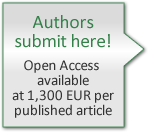Articles
All articles | Recent articles
Laser-Assisted Microwave Plasma Processing of Ceramic Coatings
M. Willert-Porada, P. Pontiller, H.-S. Park, A. Rosin
University of Bayreuth, Chair of Materials Processing, 95447 Bayreuth, Universitätsstr. 30, Germany
received March 4, 2013, received in revised form March 25, 2013, accepted April 4, 2013
Vol. 4, No. 1, Pages 1-10 DOI: 10.4416/JCST2013-00003
Abstract
The aim of Laser-Assisted Microwave Plasma Processing of materials, abbreviated as LAMPP, is to utilize a spatially well-confined laser beam to ignite and localize a microwave plasma plume as an energy source for the sintering, melting or recrystallization of ceramic coatings. The energy required for the high-temperature treatment is supplied to a significant extent from the microwave source that feeds the plasma while the laser beam is used to scan the microwave plasma over the surface area to be treated. The phenomena underlying ignition and sustainment of the plasma are described in respect of the two possible ignition mechanisms: Laser-Induced Breakdown, LIB, or Microwave-Induced Breakdown, MIB. The influence of the material to be processed on prevalence of one of these ignition mechanisms is discussed. Examples of equipment built in our laboratory to enable LAMPP in different atmospheres for different substrates and coatings are shown. As potential applications of LAMPP, re-melting of ceramic plasma-sprayed thermal barrier coatings and melting of non-stabilized ZrO2 ceramic for coating purposes are presented.
![]() Download Full Article (PDF)
Download Full Article (PDF)
Keywords
Microwave plasma, ceramic melt processing, LIB, MIB
References
1 Samant, A.N., Harimkar, S.P., Dahotre, N.B.: Laser surface modifications of advanced ceramics – a modeling approach, JOM, 59, [8], 35 – 38, (2007).
2 DeBastiani, D., Modest, M.F., Stubican, V.S.: Mechanisms of reactions during CO2-laser processing of silicon carbide, J. Am. Ceram. Soc., 73, [7], 1947 – 1952, (1990).
3 Zhang, Z., Modest, M.F.: Energy requirements for ablation or decomposition of ceramics during CO2 and Nd:YAG laser machining, J. Laser Appl., 10, 212 – 219, (1998).
4 Ihlemann, J., Scholl, A., Schmidt, H., Wolff-Rottke, B.: Nanosecond and femtosecond excimer-laser ablation of oxide ceramics, Appl. Phys. A, 60, 411 – 417, (1995).
5 Gerk, Ch., Willert-Porada, M.: Laser-assisted microwave processing as a new tool in ceramic processing, Ceram. Trans., 111, 451 – 458, (2001).
6 Brockhaus, A., Korzec, D., Werner, F., Yuan, Y., Engemann, J.: Characterization of a microwave plasma by in situ diagnostics, Surf. Coat. Tech., 74 – 75, 431 – 442, (1995).
7 Spear, K.E.: Diamond-ceramic coating of the future, J. Am. Ceram. Soc., 72, 171 – 91, (1989).
8 Zocca, A., Colombo, P., Günster, J., Mühler, T., Heinrich, J.G.: Selective laser densification of lithium aluminosilicate glass ceramic tapes, Appl. Surf. Sci., 265, 610 – 614, (2013).
9 Gerk, Willert-Porada, DE 199 511 43.8, Offenlegungsschrift DE 199 51 143 A1, (1999).
10 Liu, Y., Baudelet, M., Richardson, M.: Elemental analysis by microwave-assisted laser-induced breakdown spectroscopy: Evaluation on ceramics, J. Anal. Atom. Spectrom., 25, 1316 – 1323, (2010).
11 Vikharev, A.L., Gorbachev, A.M., Ivanov, O.A., Kolysko, A.L.: Plasma parameters and stimulated UV emission of filamentary structures in a high-pressure microwave discharge, Zh. Eksp. Teor. Fiz., 106, 172 – 185 (1994), English version: J. Exp. Theor. Phys., 79, [1], 94 – 101, (1994).
12 Janzen, G.: Plasmatechnik, Hüthig-Verl., 159 ff, (1992).
13 Pajkic, Z.: Atmospheric pressure microwave plasma assisted coating processes for particulate materials, PhD Thesis, Shaker-Verlag, Aachen, Germany, ISBN 978 – 3-8322 – 8056 – 7, (2009).
14 Gerk, Ch.: Fabrication of ceramic eutectics with simultaneous laser and microwave application, (in German), PhD Thesis, University of Bayreuth, Fortschrittberichte VDI, Reihe 5, 619 (2001), ISBN 3 – 18 – 361905 – 9.
15 Willert-Porada, M., Gerdes, T., Gerk, Ch., Park, H.-S.: Combined processes, laser assisted microwave processing and sinter coating, in Advances in Microwave and Radio Frequency Processing, Ed. M. Willert-Porada, ISBN 3 – 540 – 43252 – 3, Springer Verlag, 836 – 848, (2006).
16 Kenkre, V.M., Skala, L., Weiser, M.W.: Theory of microwave interactions in ceramic materials: the phenomenon of thermal runaway, J. Mat. Sci., 26, 2483 – 89, (1991).
17 Gerdes, T., Park, H.-S., Rosin, A., Schmidt, A., Willert-Porada, M.: Microwave antenna array for high temperature material processing, Proc. IEEE-MTT-IMS 2010, ISSN 978 – 1-4244 – 6057 – 1/10, 1424 – 1427, (2010).
18 Knoll, M., Willert-Porada, M.: Synthesis of porous silicon nitride ceramic with a compositional gradient, Mater. Sci. Forum, 631 – 632, 477 – 483, (2010).
Copyright
Göller Verlag GmbH


